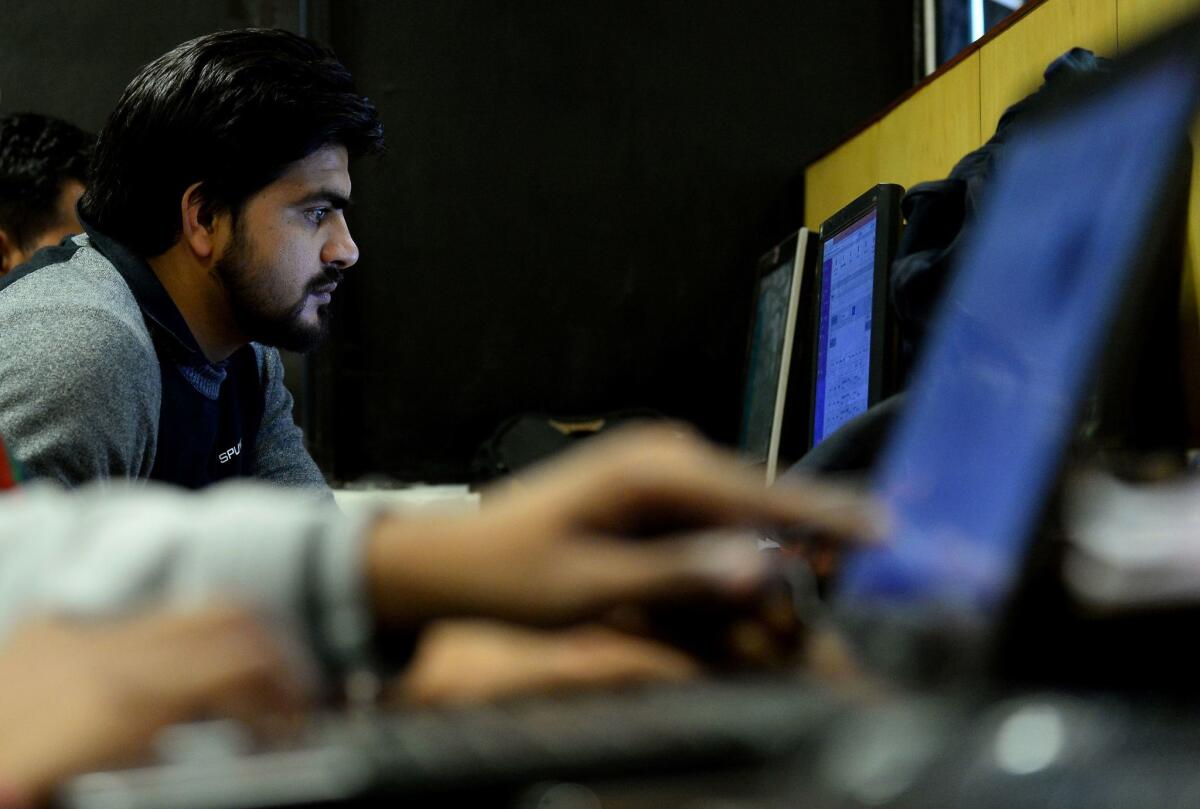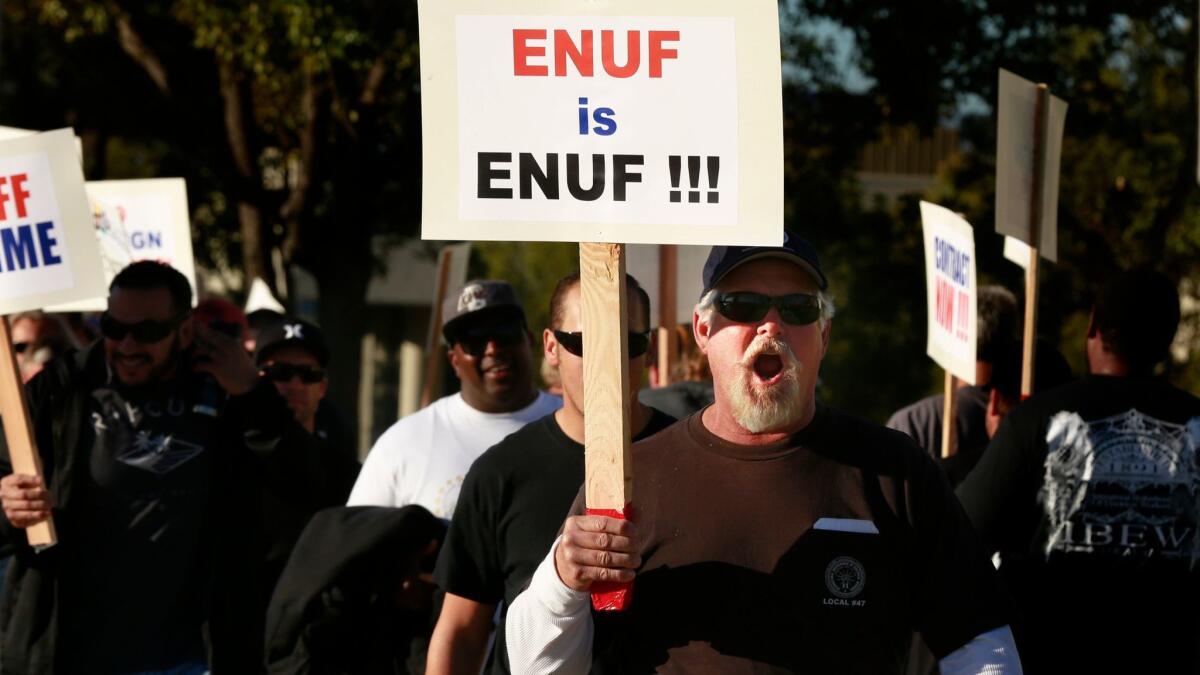What Trump’s push to limit overseas workers means for India’s army of high-tech migrant labor

Reporting from Mumbai, India — Nikhil Shravage, a 27-year-old systems engineer in the Indian industrial city of Pune, greeted President Trump’s inauguration with dread.
With a master’s in computer science and five years’ experience at a multinational company, Shravage harbors dreams of working in the United States. Every year, thousands of Indians come to the U.S. on special visas for skilled professionals, the vast majority taking temporary jobs in the tech sector.
But with Trump vowing to put “America first” and prevent U.S. jobs from going overseas, India’s army of young tech workers is bracing for new restrictions on a visa program that has represented a path to the middle class for thousands over the last two decades.
“Trump seems to be really looking out for Americans, and he will come really hard at this,” Shravage said.
Trump’s pledges to reform U.S. immigration laws and protect American workers are widely viewed in India as a threat to the visa program known as H-1B, which brings up to 85,000 foreign professionals to the United States annually, for three-year stays. Indians form by far the largest population of H-1B visa holders, although Chinese and Mexicans also obtain significant numbers of the visas.
While the program was designed to help companies hire talented foreigners with special skills, critics say that in recent years it has been dominated by Indian outsourcing giants that gobble up visas for their employees and send them to work for U.S. clients — usually for less than Americans would be paid.
Trump’s immigration orders will boost deportations. »
Previous proposals to tighten visa rules have fizzled in Congress, partly because of opposition from the banks, retailers and many other businesses that use H-1B workers. Indian outsourcing companies count three-quarters of the Fortune 500 as clients, according to industry groups.
While the H-1B program remains popular with big business, a protectionist mood is sweeping both parties in Washington under the Trump administration.
Two California members of Congress, Darrell Issa (R-Vista) and Zoe Lofgren (D-San Jose), have introduced separate legislation aimed at raising the salaries of H-1B visa holders from the current minimum of $60,000, aiming to make it harder for foreign workers to undercut Americans.
In the Senate, Illinois Democrat Richard J. Durbin and Iowa Republican Charles E. Grassley are planning a bill that would end the computerized lottery system for H-1B visas — which Indian companies flood with applications — and require employers seeking the visas to demonstrate they attempted to hire Americans first.
Indian corporate leaders also point to Trump’s nominee for attorney general, Jeff Sessions, who as a senator was one of the visa program’s toughest critics.
“Given President Trump’s inaugural speech of ‘Buy American and Hire American,’ a change to the H-1B visa regime is imminent,” said Vikram Shroff, leader of the human resources law practice at Nishith Desai Associates, an Indian law firm. “It’s only a question of when it will happen.”
That is worrying news to Indians like Prachi Dighe, 26, a software developer in Pune at Tata Consultancy Services, the biggest user of the H-1B program. In 2014, TCS was granted 5,650 visas, more than the seven top U.S. tech companies combined.
Dighe, who works on a team implementing Java software for the U.S. bank Morgan Stanley, left a smaller outsourcing company 2½ years ago to join TCS and gain a better shot at working overseas, where the salaries are three to four times higher than what Indian tech workers earn.
“The U.S. is a priority, though I do not know of a single colleague who is not looking for an opportunity to leave India,” Dighe said. “Everyone enlists themselves for projects that would enable them to go abroad.”
Such overseas stints have helped tens of thousands of young Indians boost their careers and incomes, propelling the country’s economic growth. They have also generated huge profits for the $150-billion Indian outsourcing industry, which has seen stock prices slide on expectations of fewer H-1B visas.
Shivendra Singh, vice president of global trade development at Nasscom, an Indian industry group, said previous efforts by Congress to shrink the visa program, such as by raising fees, have not reduced the number of applications because demand for foreign workers remains high.
Studies show the U.S. faces a growing shortfall of workers with STEM skills — short for science, technology, engineering and mathematics. One report suggests that while the U.S. will have nearly 1 million jobs available for computer professionals in 2022, there will be only 500,000 Americans qualified to fill them.
“The U.S. is working to develop STEM skills domestically, but this can’t be done overnight,” Singh said. “As long as that gap is there, people will be brought in on short-term visas. That approach has made corporate America very successful.”
During his election campaign, Trump said he would seek changes in the visa laws to prevent harm to American workers. The issue has gained greater traction with allegations by former employees at Walt Disney Co., Southern California Edison and even the University of California that they were laid off and then made to train their Indian H-1B replacements.

The fate of the H-1B program represents one of the thorniest issues in the growing U.S.-India economic relationship. Trump spoke by phone this week with Indian Prime Minister Narendra Modi, calling “India a true friend and partner,” although Indian officials declined to say whether the visa issue was discussed.
While more Indian engineers and software developers are finding opportunities at home — some of the country’s top tech companies are run by people who returned to India after stints in Silicon Valley — many still covet the experience of working in the U.S.
“America is an open culture in every sense,” Shravage said. “The pay is better and the work is exciting. The standard of living is better. You actually start working on real-time projects, which widen your horizons and make you a better professional.”
Shravage said he would have to sharpen his skills, aware of U.S. critics who say the H-1B program doesn’t bring in highly qualified workers — just those willing to be paid less.
“Those who have proposed the [changes] say American talent is being replaced by B-grade workers,” he said. “On a personal front, I need to be good and unique and make myself irreplaceable.”
Follow @SBengali on Twitter for more news from South Asia
ALSO
How do you say ‘lowlife’ in another language? Trump’s tweets lose much in translation
In Asia, China looks like the winner after scuttling of Trans-Pacific Partnership
A terrorist attack in Germany could have hurt Angela Merkel politically. So far, it hasn’t
More to Read
Sign up for Essential California
The most important California stories and recommendations in your inbox every morning.
You may occasionally receive promotional content from the Los Angeles Times.











